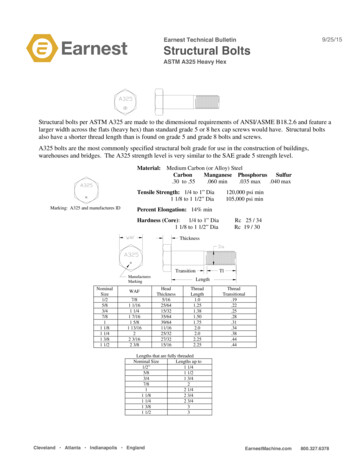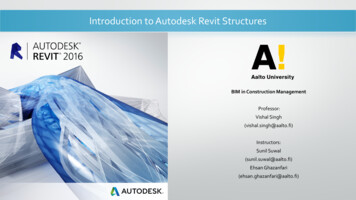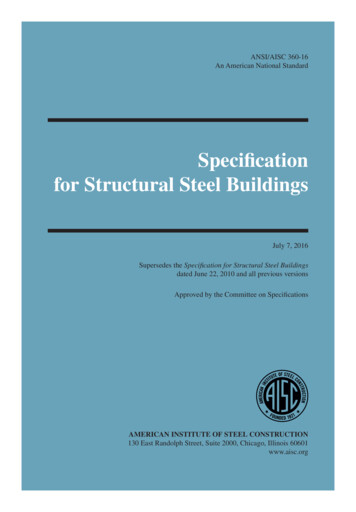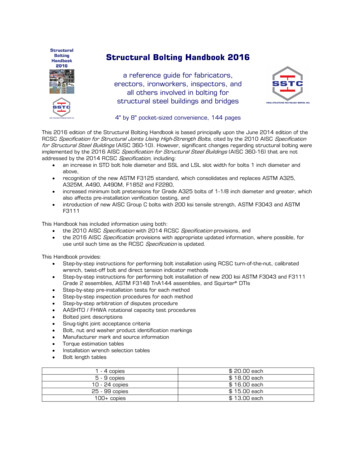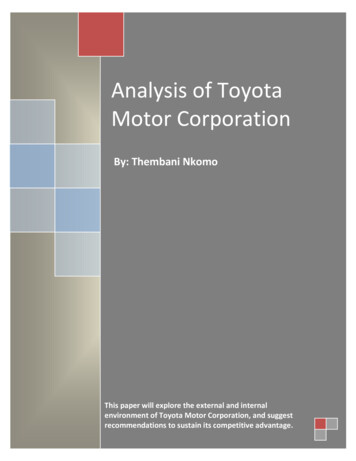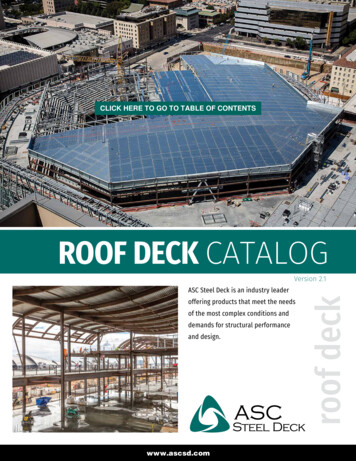
Transcription
TECHNICAL CORRECTIONJuly 2007Process Industry PracticesStructuralPIP STE03360Heat Exchanger and Horizontal VesselFoundation Design GuideReprinted by N.Kampanya
PURPOSE AND USE OF PROCESS INDUSTRY PRACTICESIn an effort to minimize the cost of process industry facilities, this Practice hasbeen prepared from the technical requirements in the existing standards of majorindustrial users, contractors, or standards organizations. By harmonizing these technicalrequirements into a single set of Practices, administrative, application, and engineeringcosts to both the purchaser and the manufacturer should be reduced. While this Practiceis expected to incorporate the majority of requirements of most users, individualapplications may involve requirements that will be appended to and take precedenceover this Practice. Determinations concerning fitness for purpose and particular mattersor application of the Practice to particular project or engineering situations should notbe made solely on information contained in these materials. The use of trade namesfrom time to time should not be viewed as an expression of preference but ratherrecognized as normal usage in the trade. Other brands having the same specificationsare equally correct and may be substituted for those named. All Practices or guidelinesare intended to be consistent with applicable laws and regulations including OSHArequirements. To the extent these Practices or guidelines should conflict with OSHA orother applicable laws or regulations, such laws or regulations must be followed.Consult an appropriate professional before applying or acting on any materialcontained in or suggested by the Practice.This Practice is subject to revision at any time. Process Industry Practices (PIP), Construction Industry Institute, TheUniversity of Texas at Austin, 3925 West Braker Lane (R4500), Austin,Texas 78759. PIP member companies and subscribers may copy this Practicefor their internal use. Changes, overlays, addenda, or modifications of anykind are not permitted within any PIP Practice without the express writtenauthorization of PIP.PRINTING HISTORYMarch 2005IssuedJuly 2007Technical CorrectionNot printed with State fundsReprinted by N.Kampanya
TECHNICAL CORRECTIONJuly 2007Process Industry PracticesStructuralPIP STE03360Heat Exchanger and Horizontal VesselFoundation Design GuideTable of Contents1. Introduction . 21.1 Purpose . 21.2 Scope. 22. References. 22.1 Process Industry Practices . 22.2 Industry Guides and Standards . 23. Definitions . 24. Design Procedure . 34.14.24.34.44.54.64.74.84.9Design Considerations . 3Vertical Loads . 3Horizontal Loads. 4Load Combinations. 6Anchor Bolts . 6Slide Plates. 7Pier Design . 8Column Design . 9Footing Design . 9Process Industry PracticesReprinted by N.KampanyaAPPENDIX: Tables, Figures, andExamples. 12Table 1 - Thermal Expansion Data. 13Figure A - Approximate ExchangerWeights . 15Figure B - Approximate Tube BundleWeights. 16Figure C - Soil Pressure for BiaxiallyLoaded Footings. 17Example 1 - Heat ExchangerFoundation. 18Example 2 - Horizontal VesselFoundation. 37Page 1 of 40
PIP STE03360Heat Exchanger and Horizontal Vessel Foundation Design Guide1.TECHNICAL CORRECTIONJuly 2007Introduction1.1PurposeThis Practice establishes guidelines and recommended procedures for use byengineers analyzing and designing heat exchanger and horizontal vessel foundationsand should be used where applicable unless otherwise specified.1.2ScopeThis Practice addresses isolated foundations supported directly on soil. Pile supportedfootings are not considered in this Practice.2.ReferencesApplicable requirements of the following Practices and industry codes and standards shall beconsidered an integral part of this Practice. The edition in effect on the date of contract awardshall be used, except as otherwise noted. Short titles will be used herein where appropriate.2.12.2Process Industry Practices (PIP)–PIP STC01015 - Structural Design Criteria–PIP STE05121 - Anchor Bolt Design GuideIndustry Guides and Standards American Concrete Institute (ACI)– ACI 318/318R-05 - Building Code Requirements for Structural Concrete andCommentary American Society of Civil Engineers (ASCE)– ASCE/SEI 7-05 - Minimum Design Loads for Buildings and Other Structures ASTM International (ASTM)– ASTM F1554 - Standard Specification for Anchor Bolts, Steel, 36, 55, and105-ksi Yield Strength3.Definitionsengineer: The engineer who performs the structural designowner: The party ultimately responsible for contract award. The owner will have authorityover the site, facility, structure or project through ownership, lease, or other legal agreement.stability ratio: The ratio of dead load resisting moment to overturning moment about the edgeof rotationthermal force: The force due to growth between piers caused by a change in temperature ofthe horizontal vessel or exchangerPage 2 of 40Reprinted by N.KampanyaProcess Industry Practices
TECHNICAL CORRECTIONPIP STE03360Heat Exchanger and Horizontal Vessel Foundation Design GuideJuly 20074.Design Procedure4.14.2Design Considerations4.1.1The engineer should review project design criteria to determine wind andearthquake loadings, corrosion allowances for anchor bolts, anchor bolttypes, and any special requirements dictated by the owner.4.1.2The engineer should verify that design is based on applicable codes inexistence when foundation drawings are issued.Vertical Loads4.2.1Dead Loads4.2.1.1 The following nominal loads should be considered as dead loads ifapplying load factors used in strength design.a. Structure dead load (Ds) - Weight of the foundation and soilabove the part of the foundation that resists upliftb. Erection dead load (Df) - Fabricated weight of the exchanger orvessel, generally taken from certified exchanger or vesseldrawingsc. Empty dead load (De) - Empty weight of the exchanger orvessel including all attachments, trays, internals, bundle,insulation, fireproofing, agitators, piping, ladders, platforms,etc. The eccentric load defined in paragraph 4.2.1.2 should alsobe added to the empty dead load weight.d. Operating dead load (Do) - Empty dead load of the exchanger orvessel plus the maximum weight of contents (includingpacking/catalyst) during normal operation. The eccentric loaddefined in paragraph 4.2.1.2 should also be added to theoperating dead load weight.e. Test dead load (Dt) - (horizontal vessels only) Empty dead loadof the vessel plus the weight of test medium contained in thesystem. The test medium should be as specified in the contractdocuments or as specified by the owner. Unless otherwisespecified, a minimum specific gravity of 1.0 should be used fortest medium. Cleaning load should be used for test dead load ifcleaning fluid is heavier than test medium. Whether test orcleaning will actually be done in the field should be determined.It is generally desirable to design for test dead load becauseunforeseen circumstances may occur. The eccentric loaddefined in paragraph 4.2.1.2 should also be added to the testdead load weight.4.2.1.2 Eccentric load - Unless more exact information about pipingsupported on the exchanger or horizontal vessel is available, thefollowing guidelines should be used:Process Industry PracticesReprinted by N.KampanyaPage 3 of 40
PIP STE03360Heat Exchanger and Horizontal Vessel Foundation Design GuideTECHNICAL CORRECTIONJuly 2007a. A load of an additional 20% of the applicable weight (empty oroperating) for exchangers with diameters less than 24 inchesb. A load of an additional 10% of the applicable weight (empty oroperating) for exchangers with diameters equal to or greaterthan 24 inchesc. A load of an additional 10% of the applicable weight (empty,operating, or test) for horizontal vesselsd. This additional load should be applied at a perpendicularhorizontal distance of D/2 plus 18 inches from the longitudinalcenterline of the vessel, where “D” is the basic diameter (basicdiameter vessel I.D. 2 times the wall thickness 2 times theinsulation thickness.) This additional eccentric load (verticalload and moment caused by eccentricity) should be distributedto each pedestal in proportion to the distribution of operatingload to each pedestal. For stacked exchangers, the weight ofonly the largest exchanger should be used to estimate theeccentric load.Comment: These eccentric loads are only guidelines andshould be checked against actual conditions whenthey become available.4.2.1.3 Load distribution (exchangers) - For most common shell and tubeheat exchangers, vertical dead loads should normally be distributedwith 60% to the channel end support and 40% to the shell endsupport. However, the actual exchanger shape and supportconfiguration should be reviewed when determining weightdistribution because in many cases load distribution may vary.4.2.2Live Loads (L)4.2.2.1 Live loads should be calculated in accordance with PIP STC01015.4.2.2.2 Load combinations that include live load in Table 5 and Table 6 inPIP STC01015 do not normally control any portion of the foundationdesign.4.3Horizontal Loads4.3.1Wind Loads (W)4.3.1.1 Wind loads should be calculated in accordance with PIP STC01015.4.3.1.2 The engineer is responsible for determining wind loads used for thefoundation design. Wind loads from vendors or other engineeringdisciplines should not be accepted without verification.4.3.1.3 Transverse wind - The wind pressure on the projected area of theside of the exchanger or vessel should be applied as a horizontalshear at the center of the exchanger or vessel. Including the windloading on projections such as piping, manways, insulation, andplatforms during the wind analysis is important. The saddle-to-pierconnection should be considered fixed for transverse loads.Page 4 of 40Reprinted by N.KampanyaProcess Industry Practices
TECHNICAL CORRECTIONPIP STE03360Heat Exchanger and Horizontal Vessel Foundation Design GuideJuly 20074.3.1.4 Longitudinal wind - The wind pressure on the end of the exchangeror vessel should be applied as a horizontal shear at the center of theexchanger or vessel. The flat surface wind pressure on the exposedarea of both piers or both columns should also be included, appliedas a horizontal shear at the centroid of the exposed area. The saddleto-pier connection will be considered pinned for longitudinal loadsunless more than one row of anchor bolts exists.4.3.1.5 Shielding - No allowance should be made for shielding from wind bynearby equipment or structures except under unusual conditions.4.3.2Earthquake Loads (E)4.3.2.1 Earthquake loads should be calculated in accordance withPIP STC01015.4.3.2.2 The engineer is responsible for determining earthquake loads usedfor the foundation design. Earthquake loads from vendors or otherengineering disciplines should not be accepted without verification.4.3.2.3 For low-friction slide plates (μ 0.2), all the longitudinal earthquakeloads should be applied at the fixed pier. For higher friction slideplates (μ 0.2), 70% of the earthquake loads should be applied at thefixed pier. Transverse and vertical earthquake loads should bedistributed in proportion to the vertical load applied to both piers.The piers are normally designed for the fixed end, and then the pierfor the sliding end is made identical, to avoid potential errors inconstruction and to reduce engineering time. If this proves to beuneconomical, the sliding end should be designed for 30% of thelongitudinal earthquake load if using low-friction slide plates, andfor 50% of the longitudinal earthquake load if using higher frictionslide plates.4.3.3Bundle Pull Load (Bp) (Exchangers)4.3.3.1 Bundle pull load should be calculated in accordance withPIP STC01015.4.3.3.2 Consideration should be given to reducing the empty weight of theexchanger owing to the removal of the exchanger head (channel) topull the bundle. The weight of the exchanger head (channel)typically is within the range of 8% to 15% of the empty weight of theexchanger.4.3.4Thermal Force4.3.4.1 Calculate thermal growth using maximum design temperature.Thermal coefficients can be found in Table 1.4.3.4.2 The thermal force used for design should be the smaller valueresulting from the following two calculations:a. The force required to overcome static friction between theexchanger or vessel support and the slide plate:Ff μ (Po)Process Industry PracticesReprinted by N.Kampanya(Equation 1)Page 5 of 40
PIP STE03360Heat Exchanger and Horizontal Vessel Foundation Design GuideTECHNICAL CORRECTIONJuly 2007where,Ff static friction forceμ coefficient of friction; refer to the values given inSection 4.6, “Slide Plates”Po nominal operating compression dead load on slideplateb. The force required to deflect the pier or column an amountequal to half of the thermal growth between exchanger or vesselsaddles:T 3Δ E I2 H3(Equation 2)where,T force from thermal expansion required to deflect pieror columnΔ total growth between exchanger/vessel saddles ε Lε thermal expansion coefficient in accordance withTable 1L length of exchanger/vessel between saddlesE modulus of elasticity of concrete pierI pier moment of inertiaH pier heightThe thermal force should be a
ASTM International (ASTM) – ASTM F1554 - Standard Specification for Anchor Bolts, Steel, 36, 55, and 105-ksi Yield Strength 3. Definitions engineer: The engineer who performs the structural design owner: The party ultimately responsible for contract award. The owner will have authority over the site, facility, structure or project through ownership, lease, or other legal agreement .



